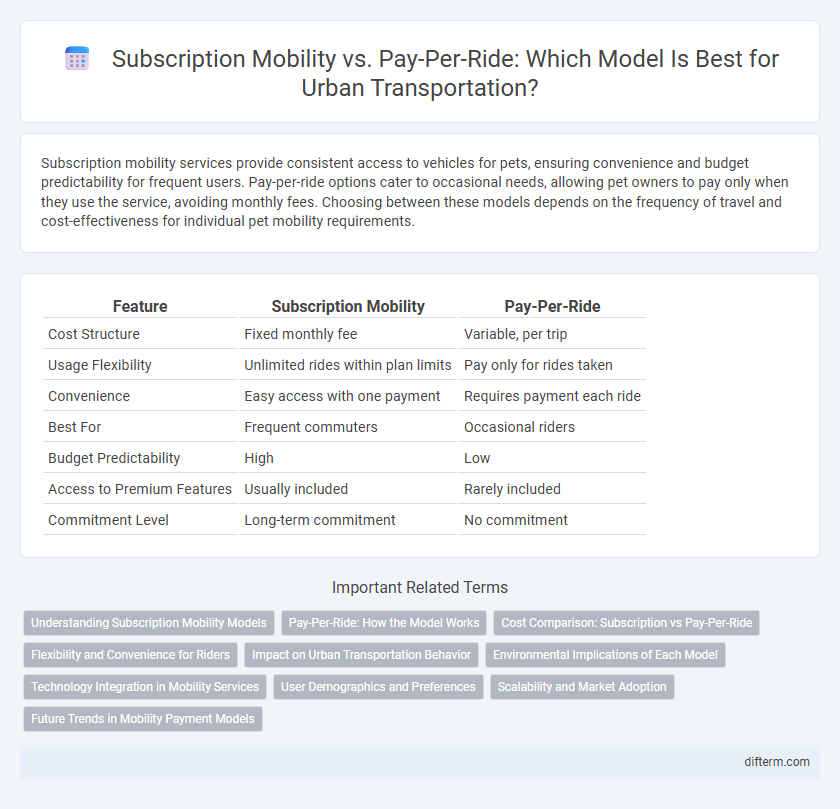Subscription mobility services provide consistent access to vehicles for pets, ensuring convenience and budget predictability for frequent users. Pay-per-ride options cater to occasional needs, allowing pet owners to pay only when they use the service, avoiding monthly fees. Choosing between these models depends on the frequency of travel and cost-effectiveness for individual pet mobility requirements.
Table of Comparison
| Feature | Subscription Mobility | Pay-Per-Ride |
|---|---|---|
| Cost Structure | Fixed monthly fee | Variable, per trip |
| Usage Flexibility | Unlimited rides within plan limits | Pay only for rides taken |
| Convenience | Easy access with one payment | Requires payment each ride |
| Best For | Frequent commuters | Occasional riders |
| Budget Predictability | High | Low |
| Access to Premium Features | Usually included | Rarely included |
| Commitment Level | Long-term commitment | No commitment |
Understanding Subscription Mobility Models
Subscription mobility models offer consistent access to various transportation options for a fixed monthly fee, providing predictability in cost and convenience compared to pay-per-ride systems. These models encourage frequent usage by bundling multiple rides or services, enhancing user commitment and loyalty. Contrarily, pay-per-ride allows flexibility without recurring costs but often leads to higher overall expenses for regular commuters.
Pay-Per-Ride: How the Model Works
Pay-per-ride mobility models charge users based on the number of trips or distance traveled, offering flexible and cost-effective transportation without long-term commitments. This model leverages real-time data tracking through mobile apps or smart cards to calculate fares accurately for each ride. Pay-per-ride options appeal to occasional riders and those seeking budget control, contrasting with subscription models that require fixed recurring fees regardless of usage.
Cost Comparison: Subscription vs Pay-Per-Ride
Subscription mobility services offer predictable monthly fees that often result in lower per-ride costs compared to pay-per-ride models, especially for frequent users. Pay-per-ride pricing can lead to higher expenses during peak usage due to variable rates and surge pricing mechanisms. Evaluating cost savings depends on individual travel frequency, with subscription plans providing financial efficiency for daily or regular commuters.
Flexibility and Convenience for Riders
Subscription mobility services offer enhanced flexibility by allowing riders to access multiple transportation modes under a single plan, reducing the hassle of separate payments and reservations. Pay-per-ride models provide convenience for occasional users who prefer paying only when they travel but may lack the seamless experience and cost savings of a subscription. Subscription plans often include features like unlimited rides, priority booking, and integrated mobility apps, significantly improving rider convenience and flexibility.
Impact on Urban Transportation Behavior
Subscription mobility models encourage consistent transit use by offering unlimited rides for a fixed fee, fostering habitual travel patterns and reducing reliance on private vehicles. Pay-per-ride systems, charging per trip, often lead to more sporadic usage, which can result in higher vehicle ownership rates and increased urban congestion. Urban transportation behavior shifts notably as subscription plans promote sustainability and efficient resource allocation through predictable demand and reduced peak-time overcrowding.
Environmental Implications of Each Model
Subscription mobility models reduce environmental impact by promoting consistent use of shared vehicles, leading to fewer cars on the road and lower carbon emissions. Pay-per-ride systems often encourage sporadic usage, which can increase the reliance on personal vehicles and result in higher emissions per trip. Studies indicate that subscription services contribute to more efficient resource utilization and decreased pollution in urban areas.
Technology Integration in Mobility Services
Subscription mobility platforms leverage advanced technology integration such as AI-driven route optimization, real-time data analytics, and seamless multi-modal connectivity to provide personalized and efficient transportation experiences. These technologies enable users to access a variety of vehicles and services through a single digital interface, enhancing convenience and reducing friction in daily travel. Pay-per-ride models typically rely on less integrated systems, resulting in slower service updates and limited customization compared to subscription-based mobility services.
User Demographics and Preferences
Subscription mobility services attract urban professionals aged 25-40 who prefer predictable monthly expenses and seamless access to multiple transportation modes. Pay-per-ride options appeal more to occasional riders, including students and tourists, valuing flexibility and lower upfront costs. Data shows subscription users prioritize convenience and time savings, while pay-per-ride users emphasize cost control and sporadic use patterns.
Scalability and Market Adoption
Subscription mobility models enable scalable growth by providing predictable revenue streams and enhancing customer retention compared to pay-per-ride systems. Market adoption accelerates as consumers favor the convenience and cost-effectiveness of unlimited access plans over variable pay-per-ride expenses. Urban mobility providers leveraging subscription services typically experience higher scalability and stronger market penetration due to consistent user engagement and simplified payment structures.
Future Trends in Mobility Payment Models
Subscription mobility models are gaining traction as they offer predictable costs and convenience, appealing to urban commuters seeking seamless multimodal access. Data indicates a surge in adoption rates, with subscription services projected to capture over 40% of the urban mobility market by 2030. Pay-per-ride systems continue to serve occasional users but face challenges in scaling due to fluctuating demand and lack of cost predictability.
subscription mobility vs pay-per-ride Infographic

 difterm.com
difterm.com